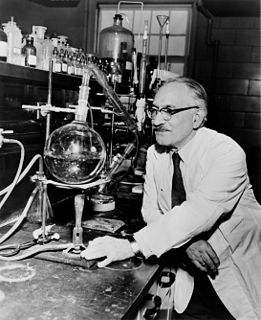Related Research Articles

Sir Alexander Fleming was a Scottish physician and microbiologist, best known for discovering the world's first broadly effective antibiotic substance, which he named penicillin. His discovery in 1928 of what was later named benzylpenicillin from the mould Penicillium rubens is described as the "single greatest victory ever achieved over disease." For this discovery, he shared the Nobel Prize in Physiology or Medicine in 1945 with Howard Florey and Ernst Boris Chain.

Selman Abraham Waksman was a Jewish Russian Empire-born American inventor, biochemist and microbiologist whose research into the decomposition of organisms that live in soil enabled the discovery of streptomycin and several other antibiotics. A professor of biochemistry and microbiology at Rutgers University for four decades, he discovered a number of antibiotics, and he introduced procedures that have led to the development of many others. The proceeds earned from the licensing of his patents funded a foundation for microbiological research, which established the Waksman Institute of Microbiology located on the Rutgers University Busch Campus in Piscataway, New Jersey (USA). In 1952, he was awarded the Nobel Prize in Physiology or Medicine for "ingenious, systematic and successful studies of the soil microbes that led to the discovery of streptomycin." Waksman and his foundation later were sued by Albert Schatz, one of his PhD students and the discoverer of streptomycin, for minimizing Schatz's role in the discovery.

Sir Cyril Norman Hinshelwood was a British physical chemist and expert in chemical kinetics. His work in reaction mechanisms earned the 1956 Nobel Prize in chemistry.

Sir Almroth Edward Wright was a British bacteriologist and immunologist.

Sir Paul Gordon Fildes was a British pathologist and microbiologist who worked on the development of chemical-biological weaponry at Porton Down during the Second World War.

Sir John Henry Gaddum was an English pharmacologist who, with Ulf von Euler, co-discovered the neuropeptide Substance P in 1931. He was a founder member of the British Pharmacological Society and first editor of the British Journal of Pharmacology.

Marjory Stephenson was a British biochemist. In 1945, she was one of the first two women elected a Fellow of the Royal Society, the other being Kathleen Lonsdale.

The Leeuwenhoek Lecture is a prize lecture of the Royal Society to recognize achievement in microbiology. The prize was originally given in 1950 and awarded annually, but from 2006 to 2018 was given triennially. From 2018 it will be awarded biennially.

Frederick William Twort FRS was an English bacteriologist and was the original discoverer in 1915 of bacteriophages. He studied medicine at St Thomas's Hospital, London, was superintendent of the Brown Institute for Animals, and was a professor of bacteriology at the University of London. He researched into Johne's disease, a chronic intestinal infection of cattle, and also discovered that vitamin K is needed by growing leprosy bacteria.
Judith Patricia Armitage is a British molecular and cellular biochemist at the University of Oxford.
John Alfred Valentine Butler was an English physical chemist best known for his contributions to the development of electrode kinetics.
Sir James Baddiley FRS FRSE was a British biochemist.
Robert Kenneth Callow, FRS was a British biochemist. He worked at the National Institute for Medical Research in Hampstead and Mill Hill, where his work on steroids included contributions to the isolation and characterisation of vitamin D, and the synthesis of cortisone from naturally occurring steroids. After he retired from the NIMR in 1966 he worked on insect pheromones at Rothamsted Experimental Station until 1971.

June Lascelles was an Australian microbiologist. She is best known for pioneering work in microbial photosynthesis.

John Raymond Postgate, FRS was an English microbiologist and writer, latterly Professor Emeritus of Microbiology at the University of Sussex. Postgate's research in microbiology investigated nitrogen fixation, microbial survival, and sulphate-reducing bacteria. He worked for the Agricultural Research Council's Unit of Nitrogen Fixation from 1963 until he retired, by then its Director, in 1987. In 2011 he was described as a "father figure of British microbiology".
Esmond Emerson Snell was an American biochemist who spent his career researching vitamins and nutritional requirements of bacteria and yeast. He is well known for his study of lactic acid-producing bacteria, developing microbiological assays for a number of key nutrients; the discovery of more than half of known vitamins has been attributed to the use of this work. He discovered several B vitamins, including folic acid, and characterized the biochemistry of vitamin B6.
Herschel Kenworthy Mitchell was an American professor of biochemistry who spent most of his career on the faculty at the California Institute of Technology. He was one of many researchers interested in vitamin B6 in the early 1940s and is credited as one of the discoverers of folic acid. He later focused his research on Drosophila, in particular the genetics and biochemistry of the heat shock response.
Mildred May Gostling, also published under her married name Mildred Mills, was an English chemist who completed research in carbohydrate chemistry. She was one of the nineteen signatories on a letter from professional female chemists to the Chemical Society requesting that women be accepted as Fellows to the Society.
John Rodney Guest, FRS is a British molecular microbiologist.
Frank William Ernest Gibson was an Australian biochemist and molecular biologist, Howard Florey Professor of Medical Research in the John Curtin School of Medical Research, and a Fellow of the Royal Society of London He undertook his most notable work at the University of Melbourne. He and his research group were responsible for the discovery of chorismic acid. He later worked at The Australian National University (ANU).
References
- 1 2 3 4 5 Gale, E. F.; Fildes, P. (1965). "Donald Devereux Woods 1912-1964". Biographical Memoirs of Fellows of the Royal Society . 11: 202–219. doi:10.1098/rsbm.1965.0014. S2CID 72751206.
- ↑ "Library and Archive Catalogue Donald Devereux Woods". London: The Royal Society. Archived from the original on 18 December 2013.